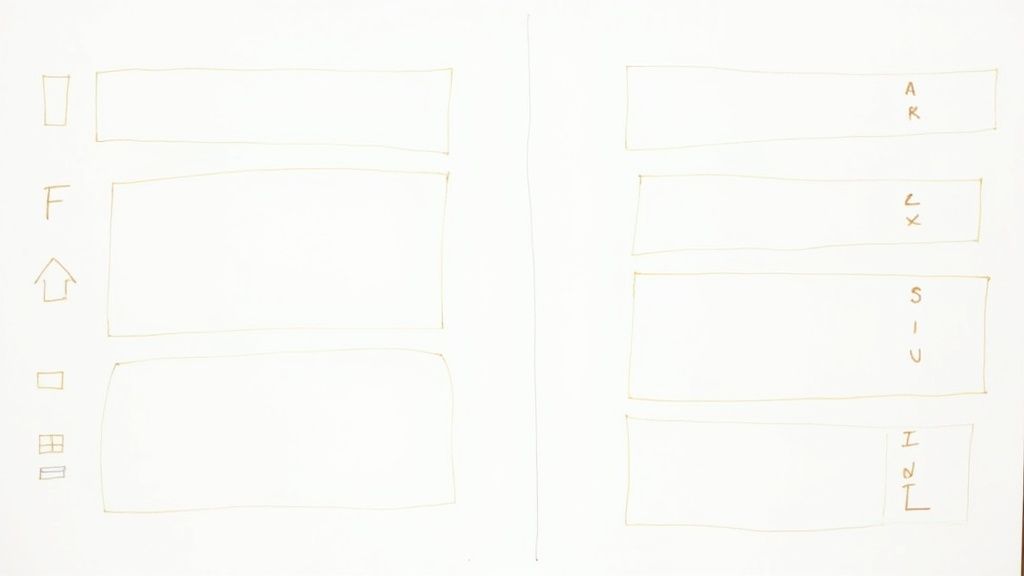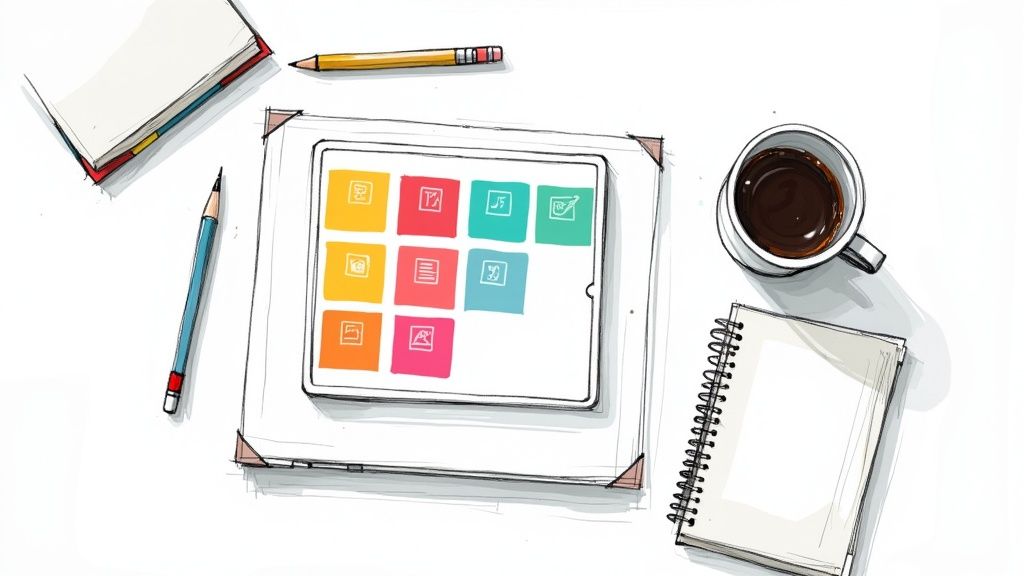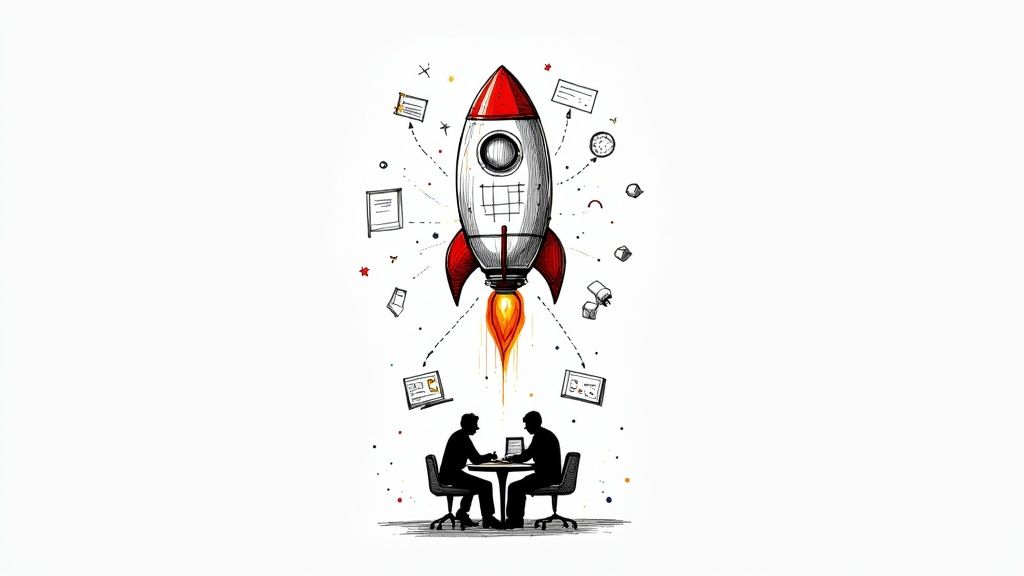Juggling client feedback, managing endless revisions, and hitting tight deadlines is the daily reality for designers. It's a creative dance that can easily turn into chaos without the right partner. Imagine this: a design agency we know nearly lost its biggest client. A critical deadline was buried in a sprawling, confusing email chain. They saved the account—and their sanity—only after they stopped trying to manage everything manually and switched to a system built for visual workflows. Their secret weapon? A project management tool that speaks a designer's language. Forget generic spreadsheets and clunky software; the right platform transforms your workflow from a tangled mess into a streamlined masterpiece.
This guide cuts through the noise to show you exactly which project management software for designers can help you reclaim your time, organize your projects, and focus on what you do best: creating stunning visuals. For a deeper dive into managing projects within a creative setting, explore this guide on creative agency project management for specialized strategies. We've analyzed the top platforms, highlighting the features that matter most to creative professionals, from proofing tools and visual timelines to seamless integrations with your design software. Each option includes a clear breakdown, screenshots, and direct links to help you make an informed decision without the guesswork. Let's find the tool that will bring order to your creative process.
1. Nora Template
Nora Template elevates Notion from a flexible workspace into a powerhouse of structured project management, making it a standout choice for designers who thrive on clarity and efficiency. It's built to eliminate common productivity hurdles like cluttered task lists and ambiguous project timelines. For example, if you're working on a project that involves numerous, interconnected steps—from initial concept to final asset delivery—Nora provides a sophisticated yet intuitive system to manage it all without feeling overwhelmed.
What truly distinguishes Nora as a top-tier project management software for designers is its intelligent workflow automation within the familiar Notion environment. Imagine you have a major design task, like "Develop UI for mobile app." With Nora, you can break this down into infinite sub-tasks with a single click. This simple action lets you granularly track every step—from wireframing to prototyping and user testing—without any tedious manual setup.
Key Features for Designers
- Infinite Sub-Task Creation: Instantly deconstruct complex design deliverables into manageable micro-tasks, ensuring no detail is overlooked.
- Smart Sprint Tracking: The integrated timeline automatically estimates progress and time, giving designers and stakeholders a clear view of project velocity and deadlines.
- Energy-Based Task Suggestions: This unique feature helps combat creative burnout. For instance, it might propose high-focus work like logo design during your peak creative hours and administrative tasks like organizing asset libraries when your energy is lower.
- Automated Backlog Management: Nora’s system intelligently archives or flags outdated tasks, keeping your workspace clean and focused on current priorities.
Practical Considerations
Nora operates exclusively within Notion, so it’s ideal for designers and teams already invested in that ecosystem. Its plug-and-play design means there is virtually no learning curve; comprehensive tutorials and strong support ensure a smooth start. Pricing begins at a one-time fee of $29 for a Personal license, with Friends ($49) and Team ($129) tiers available for collaborative environments. This model provides full feature access and unlimited workspaces, offering significant long-term value.
Website: https://www.noratemplate.com
2. Adobe Workfront
Adobe Workfront is an enterprise-level work management solution tailored specifically for in-house creative teams and marketing departments. It excels in managing complex, high-volume creative projects that require rigorous review, compliance, and governance. The platform's core strength is its deep, native integration with Adobe Creative Cloud. This means a designer can manage tasks, upload proofs, and collaborate directly within apps like Photoshop and Illustrator, eliminating the disruptive process of switching between different applications.
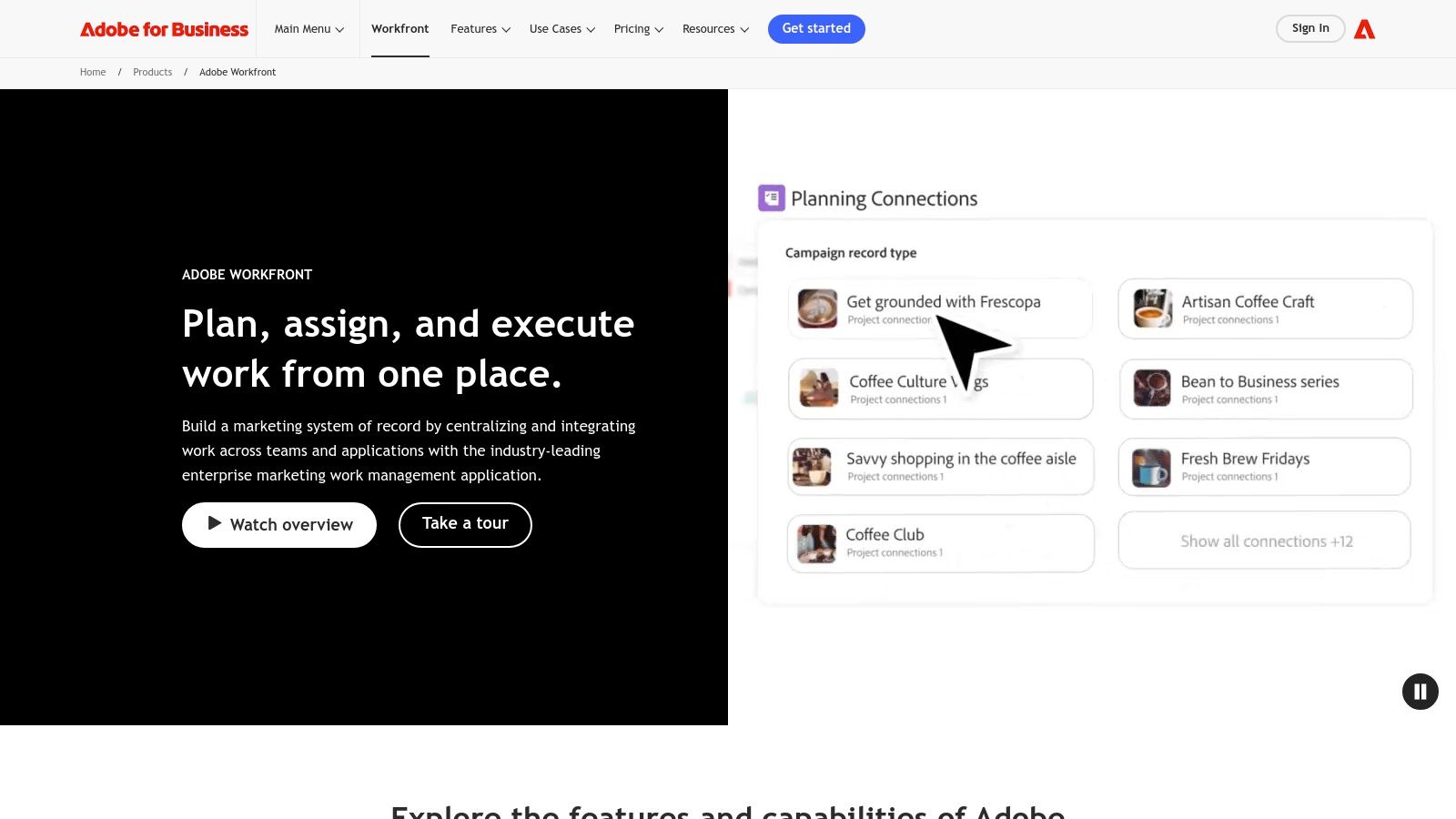
This direct connection streamlines the entire creative lifecycle, from the initial request to final approval. Workfront provides robust tools for online proofing with version control, resource management to prevent burnout, and detailed reporting for stakeholders. To see how a powerful tool like this provides structure, you can explore the 6 crucial stages of project management and map its features to your own process.
Key Differentiators & Considerations
- Pros: Purpose-built for creative operations, scales effectively across large organizations, and offers strong audit trails with role-based access controls.
- Cons: Pricing is quote-based and can be too high for smaller teams or freelancers. The initial setup requires significant organizational effort.
- Best For: Large in-house creative teams and agencies in regulated industries that need powerful project management software for designers integrated with their existing Adobe ecosystem.
3. Wrike
Wrike is a highly flexible work management platform that bridges the gap between powerful enterprise features and the agility needed by creative teams. It provides a robust set of tools specifically designed for design and marketing workflows. For instance, you can use its customizable request forms to create streamlined creative briefs, ensuring you get all the necessary information upfront. It also has a sophisticated proofing and approval system. The platform’s direct integration with Adobe Creative Cloud allows designers to work within their native applications while keeping project stakeholders updated in real time.
This focus on the creative process makes Wrike an excellent choice for teams that need strong project management software for designers without the complexity of a full enterprise system. Its built-in templates for marketing campaigns, content creation, and event management help teams get started quickly. Additionally, features like resource planning, time tracking, and detailed dashboards give managers the visibility needed to balance workloads and measure performance effectively.
Key Differentiators & Considerations
- Pros: Strong creative tooling, including digital proofing and approvals, that scales well from small teams to large departments. It is fast to configure with useful templates and automation rules.
- Cons: Unlocking its full value often requires the higher-priced Business tier or purchasing add-ons. The user interface can feel complex for individuals or very small teams.
- Best For: Marketing and creative teams looking for a versatile, scalable platform with dedicated tools for managing creative intake, proofing, and project delivery across an organization.
4. monday.com Work Management
monday.com Work Management is a visually intuitive and highly customizable platform that excels in organizing creative workflows with its vibrant, color-coded interface. Its core strength is its flexibility. A design studio can build a completely custom project dashboard that mirrors its exact process—from creative briefs and asset production to client feedback loops. The platform's extensive template gallery, with options specifically for creative workflows, provides a great starting point, so you don't have to build from scratch.
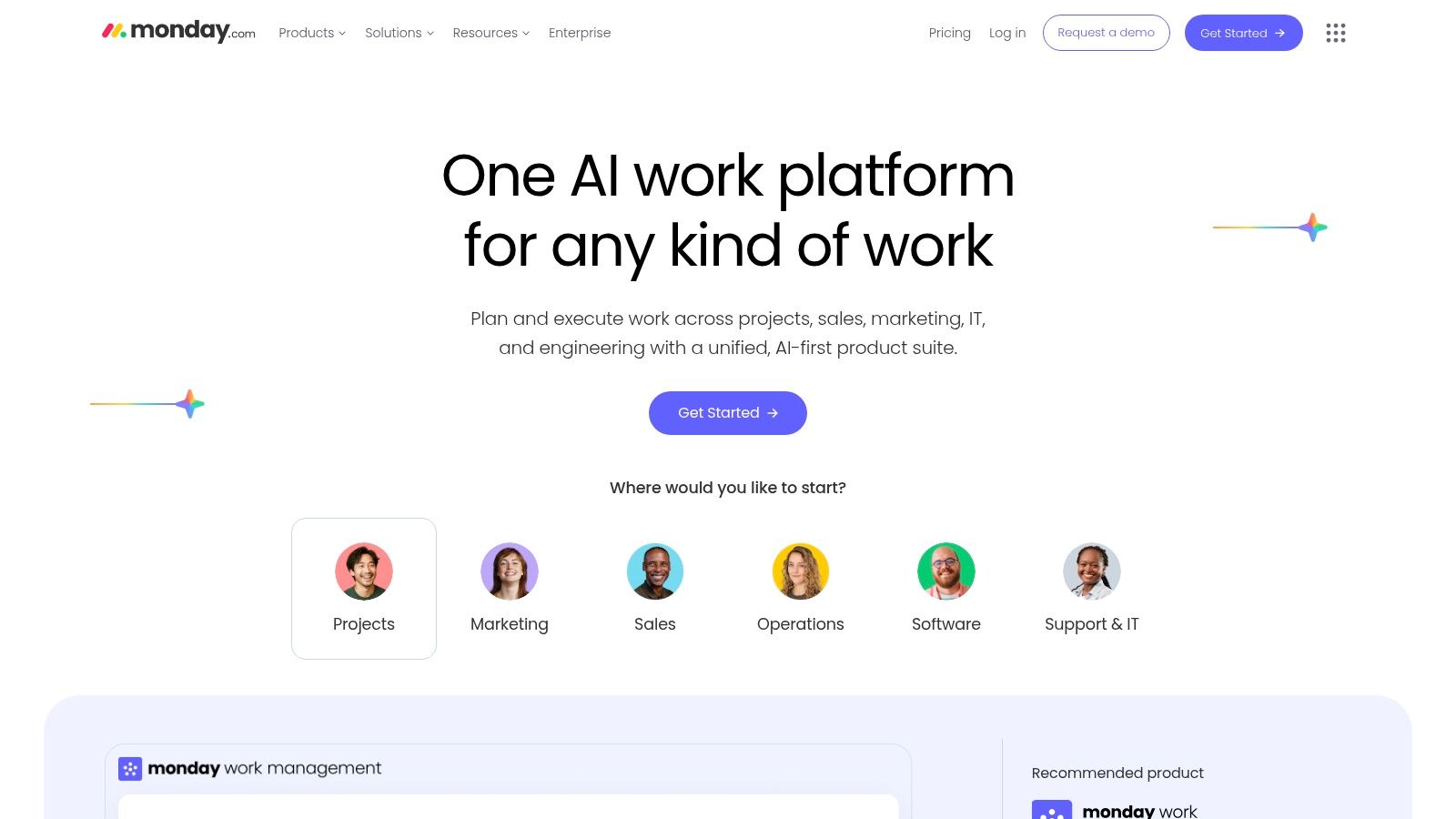
With powerful automations, teams can eliminate repetitive administrative tasks. For example, you can set up a rule to automatically notify a stakeholder when a design stage is complete or assign a proofreader once a draft is uploaded. This focus on visual management makes it one of the top choices for project management software for designers who prefer a graphical overview of their projects. For a deeper look at similar platforms, you can find a comprehensive breakdown of the best workflow management tools to compare features.
Key Differentiators & Considerations
- Pros: Very approachable user interface enabling quick setup, a strong library of templates specific to creative projects, and competitive pricing across different tiers.
- Cons: Advanced features like time tracking and larger dashboards require higher-tier plans. Seats are often sold in bundles, which can lead to higher minimum costs for very small teams.
- Best For: Design studios, agencies, and in-house marketing teams that need a flexible, visually-driven tool to manage multiple projects and client-facing workflows.
Visit monday.com Work Management
5. Asana
Asana has evolved from a simple task manager into a robust work management platform that helps creative teams connect their design work to broader company objectives. It's particularly good at facilitating collaboration between designers and other teams like marketing and product. The platform's strength lies in its clear, structured interface and powerful features for planning, tracking, and managing complex creative workflows from start to finish.
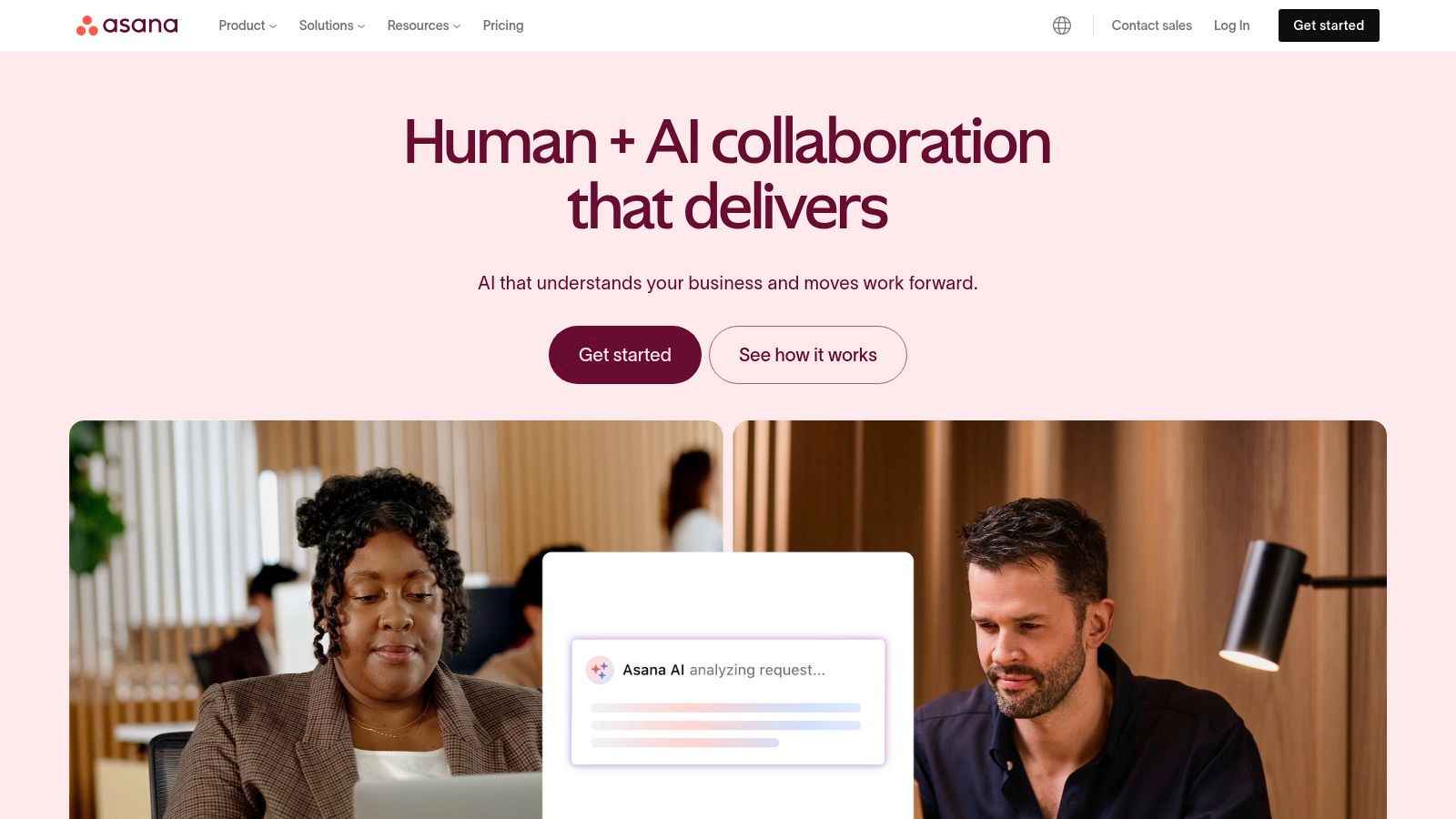
With features like Timeline views for project planning, custom forms for creative briefs, and built-in proofing tools, Asana helps centralize feedback and approvals directly on design assets. This ensures every piece of creative work is aligned with project requirements from the outset. For designers, this means clearer briefs and fewer revision cycles, especially when teams implement clear acceptance criteria for user stories within tasks. Its Portfolios and Workload features provide managers with a high-level view of team capacity and project progress, preventing burnout.
Key Differentiators & Considerations
- Pros: Clean user experience and a mature ecosystem with over 100 integrations. Strong cross-team collaboration tools and easy guest access for clients.
- Cons: Advanced features crucial for designers, like workload management and approvals, are locked behind higher-tier subscriptions. Its structured nature may feel restrictive for teams accustomed to more freeform tools.
- Best For: Creative teams and agencies that require a highly organized system to manage projects across different departments and need strong reporting capabilities to track progress against business goals.
6. ClickUp
ClickUp positions itself as the "one app to replace them all," offering a highly customizable, all-in-one work hub that appeals to design agencies and creative teams looking to consolidate their tools. Its platform combines tasks, documents, whiteboards, and chat into a single ecosystem. In practice, this means you could manage a design sprint using a Kanban board, map out a project timeline with a Gantt chart, and collaborate on mood boards using its built-in whiteboard feature—all without ever leaving the app.
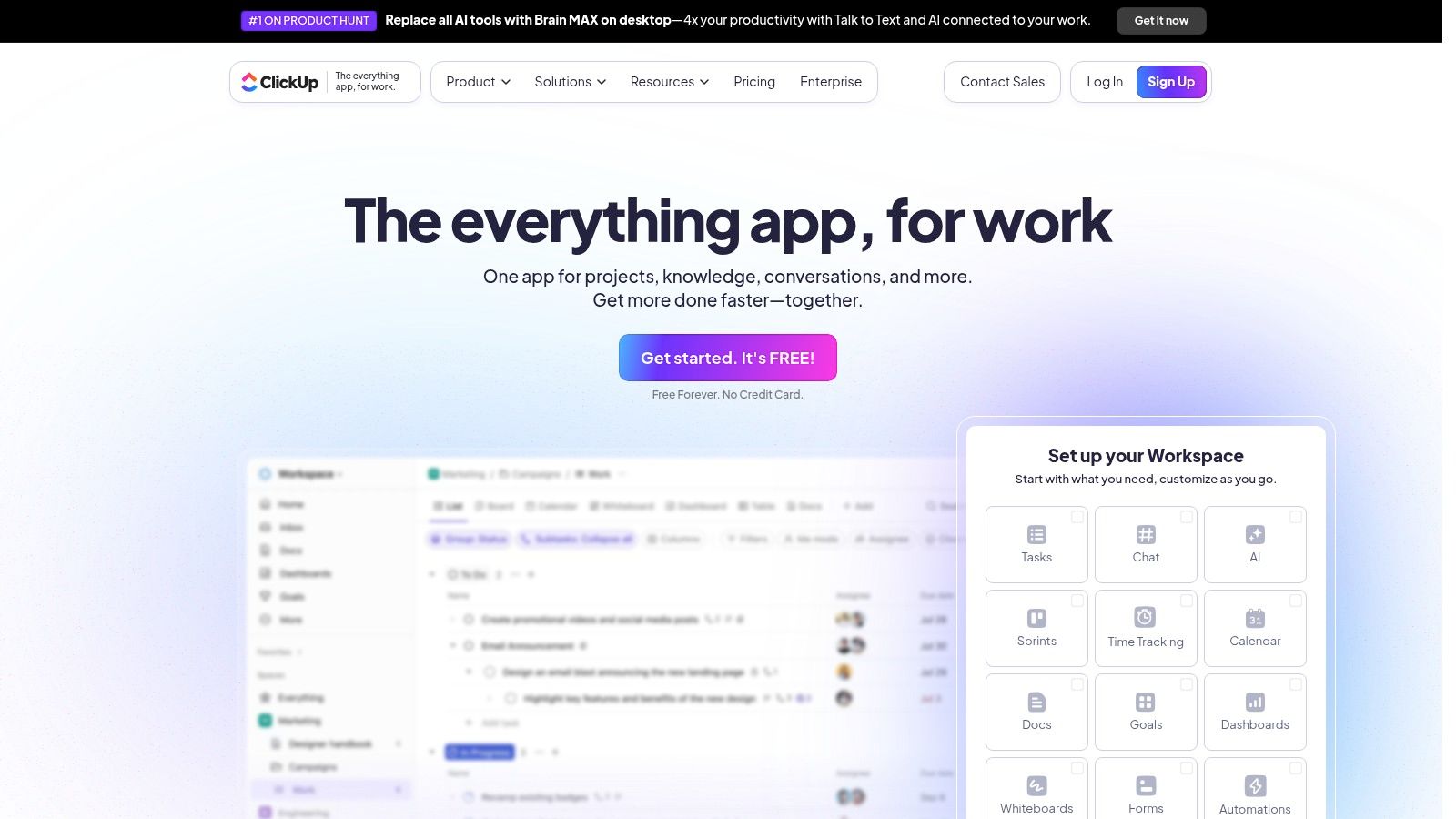
The platform's strength lies in its flexibility. You can build custom workflows for everything from client intake to final asset delivery using its robust templating engine. Features like guest access and granular collaboration controls make it easy to loop in clients for feedback, while its extensive integrations allow for proofing and version control. The optional ClickUp Brain AI add-on further streamlines workflows by summarizing long documents and automating routine tasks.
Key Differentiators & Considerations
- Pros: High feature density and excellent customizability at affordable price points. It provides strong value for agencies needing multiple views and templates, backed by an extensive integrations ecosystem.
- Cons: The sheer number of features can create a steep learning curve, potentially overwhelming new users. Some advanced admin and role-based features are only available on higher tiers or as paid add-ons.
- Best For: Creative agencies and in-house teams who want a single, highly adaptable piece of project management software for designers that can be tailored to their specific, and often complex, workflows.
7. Basecamp
Basecamp is a communication-first project management system that champions simplicity and clarity, making it a favorite for design agencies managing client-facing projects. Instead of overwhelming users with complex features, it consolidates everything into a single, organized space for each project. This space contains message boards, to-dos, schedules, and file storage. This straightforward approach makes it easy for everyone to learn, especially clients who need to participate in the feedback loop.
The platform intentionally guides teams toward a more organized way of communicating, which helps avoid scattered emails and chaotic chat messages. For visual workflow management, its "Card Table" feature provides a simple Kanban-style board. The core idea is to provide one central source of truth for every project, ensuring designers, project managers, and clients are always on the same page without needing extensive training.
Key Differentiators & Considerations
- Pros: Exceptionally easy for clients to understand and use, a flat-rate pricing option can be cost-effective for larger teams, and the minimal, focused interface requires little setup.
- Cons: Lacks advanced project management features like Gantt charts or detailed reporting. Native visual proofing tools are limited, relying instead on standard file attachments and comments.
- Best For: Freelance designers and agencies that prioritize clear client communication and a simple, all-in-one system over granular task management and complex workflow automation.
8. Notion
Notion is a uniquely flexible, all-in-one workspace that blends task tracking, documentation, and knowledge management into a single platform. For designers, its strength lies in its ability to house an entire project lifecycle. You can create the initial creative brief and mood boards, then build out detailed design specs, track asset handoffs, and compile final documentation—all in one place. The platform’s modular, block-based system allows teams to build completely custom workflows without writing a single line of code.
This customizability makes it an exceptional project management software for designers who want to consolidate their tools. Instead of jumping between a task manager, a document editor, and a wiki, you can link tasks directly to their corresponding design files and project briefs. The rich community ecosystem provides a wealth of inspiration, and you can explore some of the best project management templates to see how Notion can be adapted for design sprints, content calendars, and more.
Key Differentiators & Considerations
- Pros: Seamlessly combines project specs and documentation with task tracking, is highly customizable with a designer-friendly interface, and is cost-effective for small to mid-sized teams.
- Cons: Less structured than dedicated PM tools, which can be overwhelming without a clear plan. Heavy database use may require careful organization to maintain performance.
- Best For: Design teams, freelancers, and studios looking for a single source of truth to manage projects, knowledge, and operational documentation in one unified, flexible space.
9. Trello
Trello is the classic Kanban-based project management tool, offering a highly visual and intuitive card system that is simple yet flexible. For designers, it provides a straightforward way to track tasks as they move through different stages of a project, such as "To-Do," "In Progress," "Client Review," and "Approved." Each card can hold checklists, attachments like design mockups, due dates, and comments, creating a central hub for each specific task.
The platform's strength is its approachability, allowing clients and non-technical stakeholders to easily collaborate without a steep learning curve. While the core functionality is simple, Trello's "Power-Ups" extend its capabilities by integrating with apps like Slack, Figma, and Google Drive. Butler, its built-in automation engine, can handle repetitive actions, such as moving a card when a checklist is completed. This makes it a surprisingly capable project management software for designers who value ease of use.
Key Differentiators & Considerations
- Pros: Very easy for creatives and clients to learn and adopt, lightweight and fast with an excellent free plan, and features an extensive library of templates and third-party "Power-Up" integrations.
- Cons: Limited native reporting and resource management capabilities. Advanced views like timelines and dashboards require upgrading to Premium or Enterprise plans.
- Best For: Freelance designers, small agencies, and teams that need a simple, visual, and highly customizable way to manage creative workflows without the overhead of more complex systems.
10. Airtable
Airtable is a powerful spreadsheet-database hybrid that offers unparalleled flexibility for creative workflows. Instead of rigid project templates, it allows designers and teams to build custom databases to track everything from design assets and creative briefs to production calendars and client feedback. For example, you could create one database for all your creative assets and another for client projects, then link them together to see exactly which assets are being used in which project.
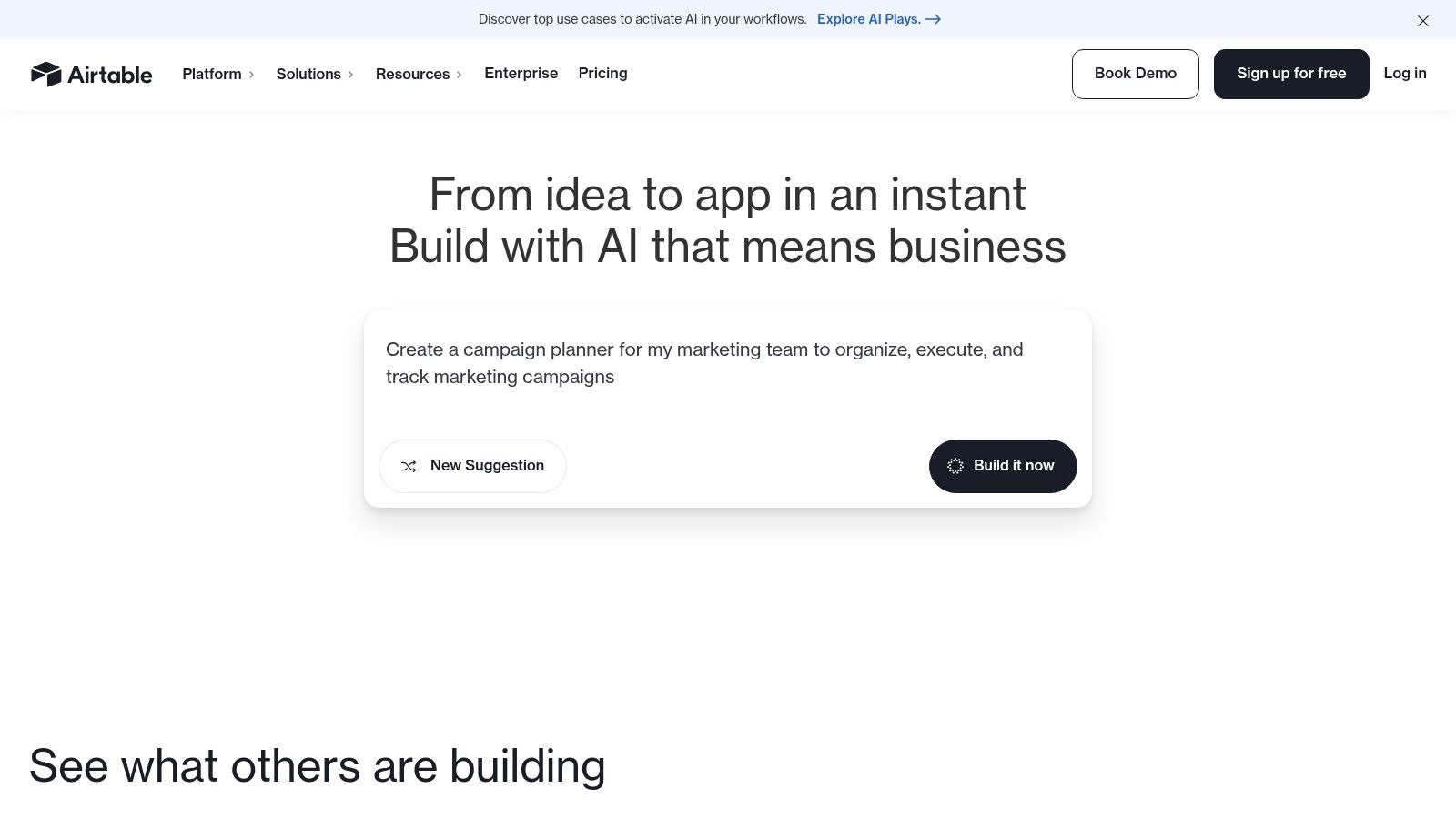
This platform moves beyond simple task lists by providing multiple views like Kanban, timeline, and calendar, allowing teams to visualize work in the way that best suits them. Designers can use Airtable's Interface Designer to build simple, visual apps for stakeholders to submit requests or review progress without getting lost in the backend data. This makes it a fantastic project management software for designers who need to manage both creative assets and project timelines in one place.
Key Differentiators & Considerations
- Pros: Extremely flexible for building custom creative pipelines and asset catalogs, scales well from small studios to large teams, and offers strong API and automation capabilities.
- Cons: The initial database setup requires upfront planning and administrative time. Record and attachment limits on lower tiers can be restrictive.
- Best For: Creative teams and agencies that need a highly customizable solution to build and manage bespoke workflows, digital asset management (DAM) systems, and content calendars.
11. TeamGantt
TeamGantt is an intuitive, Gantt-first project management tool favored by creative agencies that need crystal-clear timelines and client-friendly project visualization. Its primary strength is making complex schedules easy to understand. It allows designers and project managers to easily map out dependencies, set baselines, and track progress against a visual timeline. The platform is designed to simplify planning without overwhelming users with excessive features.
This focus on the Gantt chart makes it exceptional for projects with sequential creative phases, such as a website redesign where one task must finish before the next can begin. Beyond its core chart view, TeamGantt offers calendar, list, and Kanban board views to accommodate different workflows. It also includes straightforward workload and resource tracking, which helps prevent team burnout by showing who is working on what at any given time.
Key Differentiators & Considerations
- Pros: Features one of the clearest and most user-friendly Gantt interfaces available, making it easy for clients to visualize schedules. It also has a straightforward pricing model with a free trial.
- Cons: The platform has fewer features compared to larger all-in-one alternatives, with more basic collaboration and reporting options.
- Best For: Design agencies and small to mid-sized teams looking for a simple yet powerful project management software for designers that excels at timeline planning and client communication.
12. Smartsheet
Smartsheet offers a unique, spreadsheet-style approach to work management that appeals to teams accustomed to the grid-based logic of tools like Excel but who need more powerful project management capabilities. It's a highly flexible platform that can manage complex creative programs, especially those requiring cross-departmental coordination. While not a creative-first tool out of the box, its optional add-ons for proofing and content review make it a viable, data-driven option for larger creative operations.
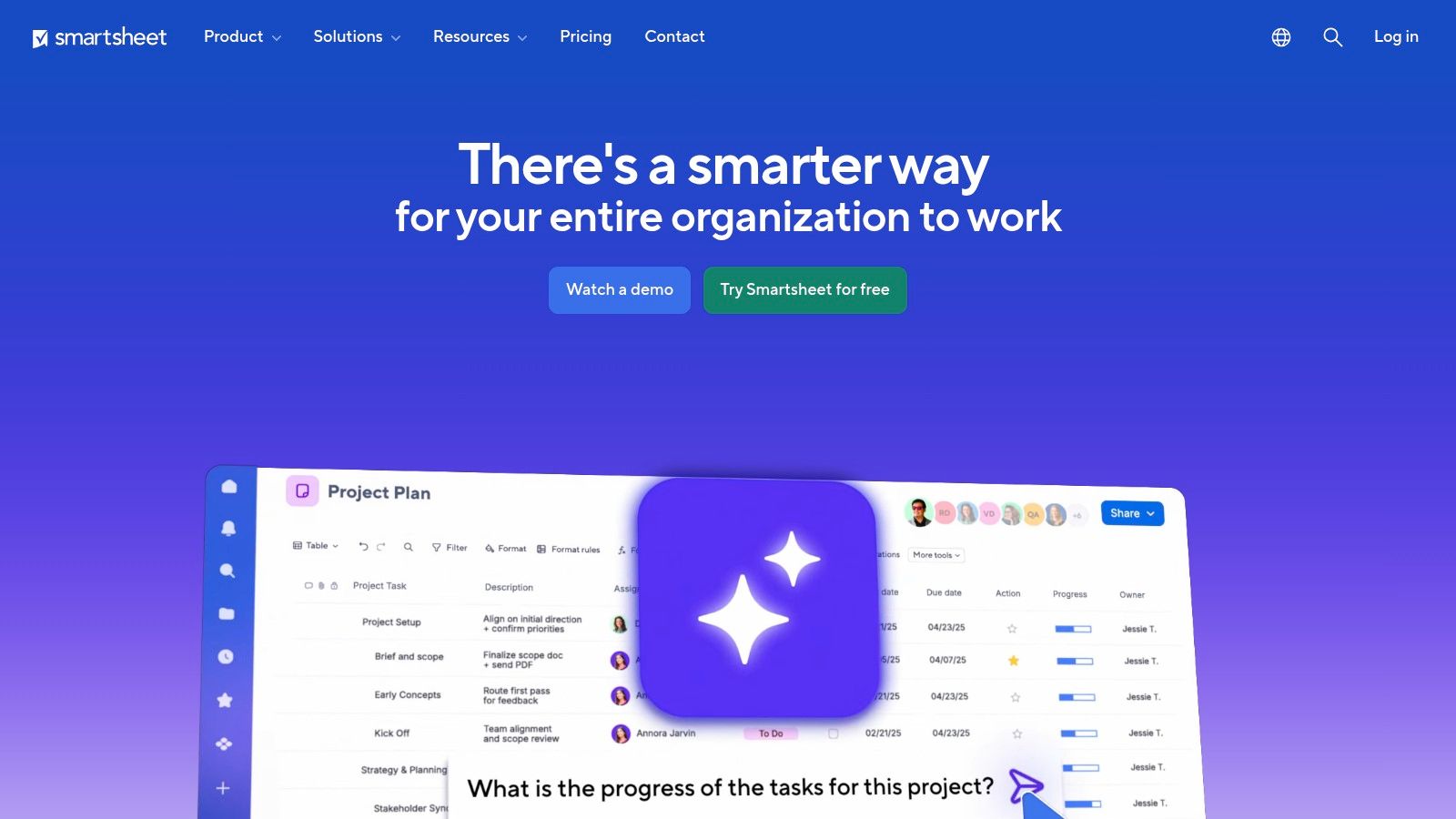
The platform’s strength is its ability to create powerful automations, reports, and dashboards from a familiar sheet interface. For a practical example, a marketing team could use a Smartsheet to track an entire campaign, with rows for each design asset. An automation could then alert a designer when a new asset request is added and notify the social media manager once the design is approved. This makes Smartsheet a solid piece of project management software for designers embedded in larger, more operationally focused organizations.
Key Differentiators & Considerations
- Pros: Familiar spreadsheet interface minimizes the learning curve, provides strong governance and portfolio-level visibility, and excels at coordinating work across different departments.
- Cons: Can feel more operational than creative without purchasing specific add-ons. The pricing model can become expensive as teams grow and require more features.
- Best For: Large creative teams or agencies that require a highly customizable, data-centric platform for managing complex projects and aligning with other business units.
Project Management Software Comparison for Designers
Choosing the Right Canvas for Your Workflow
The journey to finding the perfect project management software for designers is not about discovering a single "best" tool, but about identifying the right canvas for your unique creative process. We've explored a wide spectrum of platforms, from the enterprise-grade power of Adobe Workfront and the detailed, analytics-driven approach of Wrike to the visual simplicity of Trello's Kanban boards. Each option presents a different philosophy for organizing creative chaos.
For teams that thrive on visual planning and vibrant interfaces, platforms like monday.com and Asana offer robust, colorful ecosystems. Meanwhile, tools such as ClickUp and Notion champion the "all-in-one" workspace, promising to replace a scattered tech stack with a single source of truth. The key is to look past the feature lists and focus on how a tool feels in practice. Does it reduce friction or add another layer of complexity? Does it adapt to your workflow, or force your workflow to adapt to it?
How to Make Your Final Decision
Selecting the right project management software for designers requires a thoughtful evaluation of your team's specific pain points and goals. Don't let the sheer number of options overwhelm you. Instead, use this simple, three-step approach to narrow down the contenders.
First, identify your non-negotiables. Do you absolutely need Gantt charts for long-term project mapping, as offered by TeamGantt? Is seamless client feedback and approval a top priority? Pinpointing these critical needs will immediately filter out unsuitable options.
Next, consider your team's size and technical comfort level. A small, agile design studio might find the straightforward, communication-focused style of Basecamp ideal. A larger agency juggling complex, data-heavy projects might lean towards the spreadsheet-like power of Smartsheet or Airtable.
Finally, always run a pilot test. Sign up for free trials with your top two or three choices and use them for a real, small-scale project. This hands-on experience is the only way to truly understand how the software fits into your day-to-day operations and whether it enhances or hinders your creative flow. For example, you can take a recent small project, like designing a single social media graphic, and run it through each tool. This allows you to see how easy it is to set up tasks, attach files, leave comments, and mark the project as complete.
Ultimately, the best project management software is one that becomes an invisible, supportive partner in your creative work. It should clear the administrative clutter, clarify communication, and give you back your most valuable resource: the time and mental space to design.
Ready to build a design workflow that’s as elegant as your final product? Nora Template transforms Notion into a powerful, pre-built project management system specifically for designers. Stop building from scratch and start organizing your projects, clients, and assets today with the Nora Template.
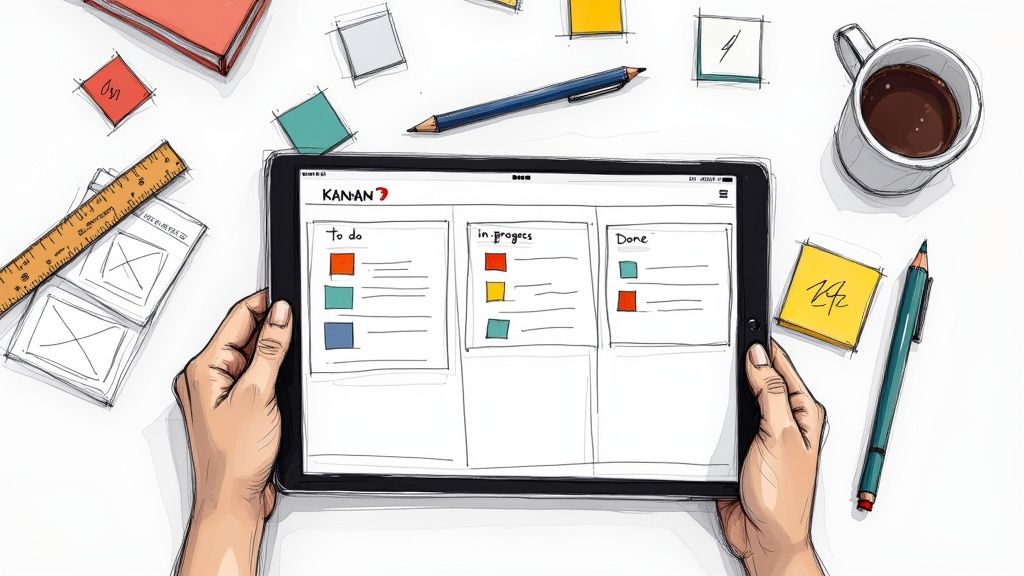
.svg)
